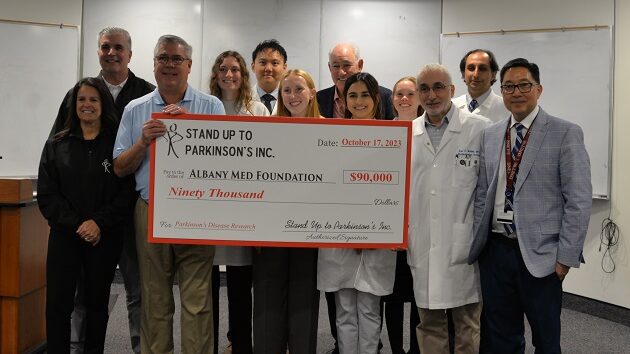Stand Up to Parkinson’s Continues Support of Leading-Edge Research

Since 2019, Stand Up to Parkinson’s has been raising funds to bring awareness to Parkinson’s disease in the Capital Region, support programming for local patients, and further local research and treatment efforts. Founded by Tim Lange, who was diagnosed with Parkinson’s in 2017, the organization holds several events each year, with all funds raised going to support Parkinson’s research and programs that provide opportunities for Parkinson’s patients to live more rewarding lives.
A progressive, neurodegenerative disease, Parkinson’s is characterized by tremor, slowness, stiffness, and imbalance. According to the Parkinson’s Foundation, it affects nearly one million people in the U.S.
While there is currently no cure, Damian Shin, PhD, interim chair and associate professor in the Department of Neuroscience and Experimental Therapeutics at Albany Medical College, and his lab team are working to discover new ways for symptomatic treatment and to slow down, or even prevent, this devastating disease.
At a recent special event, board members from Stand Up to Parkinson’s heard first-hand about the Shin lab’s research projects and presented Dr. Shin, Eric Molho, MD, director of Albany Medical Center’s Movement Disorders Center, and student scientists with a $90,000 donation to advance their research efforts.
“We’re committed to finding a cure for Parkinson’s and we’re proud to partner with Albany Medical College as part of that mission,” said Dan Smith, vice president of Stand Up to Parkinson’s.
Dr. Molho, whose patients have participated in clinical trials aimed at slowing the disease’s progression, stressed the importance of funding for research that leads to new ideas. “Research gives hope to patients that tomorrow will be better than today,” he said.
Much of the research on Parkinson’s in Dr. Shin’s lab centers on ultrasound neuromodulation, which uses focused sound waves to target specific tissue areas. First-year medical student John Chen explained how they are using this technique to target inflammation in the gut, hypothesizing that it could one day be used as a preventative therapeutic.
Similarly, fourth-year doctoral student Kainat Akhtar described how they’re testing whether focused ultrasound could be used as a possible treatment for constipation, a common complication of Parkinson’s. Current therapies can have adverse effects, including damaging the interior of the colon.
Rachael Herlihy, a third-year student in the joint MD/PhD degree program, elaborated on their research on depression, another complication seen in about fifty percent of Parkinson’s patients. They employ animal models to test whether applying focused ultrasound to the peripheral nervous system can alter brain activity in a way that improves depressive behavior.
The lab is also actively involved in pre-clinical discovery science, including investigating the role of the cerebellum and basal ganglia in Parkinson’s. First-year MD/PhD student Shelby Sabourin explained that they hope to use their findings from these studies to explore new pathways for treatment.
Julia Brzac, a research technician whose position is made possible in part by Stand Up to Parkinson’s, detailed the numerous lab projects she’s involved in, including studies on how gene therapy can correct underlying abnormal brain oscillations in Parkinson’s. She’s also investigating potential treatments that target the fatigue experienced by people with Parkinson’s, and that could alleviate disease progression and spare cell death.
Support for research like this makes a difference to science and education today – and long after – noted Mandeep Sidhu, MD, associate dean for clinical sciences and research affairs. “Humanity underlies medicine and biomedical research,” he said. “Each discovery impacts patient care at the bedside.”
Learn more on the 'Make a Gift' page about how gifts like that from Stand Up to Parkinson’s help Albany Medical College researchers continue to make extraordinary contributions to improving health care and furthering biomedical research.